Vol 5 No. 41 TROPIC LIGHTNING NEWS October 26, 1970
| Unit Page | Unit Page | Unit Page | Unit Page |
| 125th Signal 2 | 2/22 4 | 25th Med 6 | 44th Scout Dog 8 |
| 159th Dustoff 8 | 2/27 1 | 25th Med. 8 | 4/9 1 |
| 2/12 Photo 1 | 2/34 1 | 25th MP 3 | 58th Med 8 |
| 2/14 2 | 2/34 6 | 3/13 3 | 65th Engr 7 |
| 2/22 1 | 2/34 8 | 4/23 2 | 7/11 Photo 1 |
| 2/22 Photo 3 |
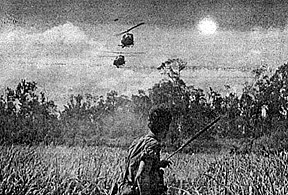 RIGHT THIS WAY - An radio telephone operator (RTO) with the 2nd battalion, 12th Infantry looks skyward at friendly division chopper during an operation near Dau Tieng. (Photo by SP4 Ed Toulouse) |
MARKING ROUND - A pair of artillerymen from Alfa Battery, 7th Battalion, 11th Field Artillery chamber a "Willly Peter," the artillery's nickname for a marking round, white phosphorous. (Photo by SP4 Tom Benn) | 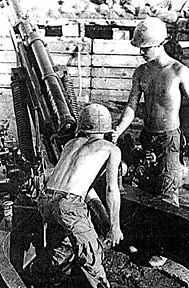 |
Plows Blow Booby-Traps
Triple Deuce Finds Cache
By SP4 FRANK SALERNO
CU CHI - While working with a land clearing unit 15 miles north of here
recently, the 25th Division's 2nd Battalion (Mech), 22nd Infantry, found a large enemy
ammunition cache.
During this operation the second platoon of Alfa Company was providing
security with their armored personnel carriers for the 984th Land Clearing Company, which
used rome plows to clear away dense brush and trees.
Prevent Casualties
"The plows also prevented possible US casualties by detonating
enemy boobytraps which went undetected by us," said Sergeant James McDonnel of Alfa
Company.
"Later in the day as the plows continued to clear the area, one
uncovered a large tunnel which was under the jungle covering," continued the
Collbran, Colo. squad leader.
Find Plenty
When the men dismounted their tracks and checked out the tunnel
cautiously, they found plenty. Included in the cache were seventeen 75mm recoilless rifle
rounds, one hundred and seventy 57mm recoilless rifle rounds and a 55-gallon drum of tear
gas powder.
Shortly afterwards, the cache was evacuated and the tunnel destroyed.
"I'm sure glad we found those rounds because with them the enemy could
have done us a J-O-B," said Specialist 4 Dennis Briese of Elmo, Kan.
Leg and Armor Units Grab
Charlie's Chow
By SP4 PHIL MASLIN
CU CHI While working with an armored unit near here recently, 25th
Division soldiers made a dinnertime sweep and took the supper right off Charlie's table.
They may have taken a little of the romance out of his life as well.
Alfa Company, 2nd Battalion, 27th Infantry, teamed with chain-pulling
Sheridans of the 2nd Battalion, 34th Armor, and found a cache in a suspected
enemy-infested area 11 miles north of here.
Trap Door
"We were sweeping behind the tanks," said Specialist 4 Jerry
Pals of Sheffield, Iowa," when we noticed a trap door partly knocked in by the tanks.
After checking for booby-traps, we found 16 bags of rice in good condition."
"We proceeded about 100 yards when the tanks marked a tunnel with
smoke," said Private First Class Clyde Hesser of Clear Lake, lowa. "Moving with
caution, we discovered a large bunker containing a cooking area, sleeping positions and
more enemy supplies."
Big Haul
The combined leg and Armor operation uncovered 675 pounds of enemy rice,
16 cans of meat, 10 pounds of dried fish and assorted other food supplies. Also evacuated
were 500 rounds of new small arms ammunition, 150 sandbags and 30 packs of Vietnamese
cigarettes.
"Further investigation disclosed a small complex of four bunkers
arranged in a circular pattern similar to that used in GI perimeter defense," said
Sergeant Byrle Darland of Bowie, Tex.
"In one we discovered a strong and almost forgotten scent of perfume and
some female-type garments."
Waiting Pays Off for
Division Unit
Manchu Platoon Practices the Virtue of Patience
By SGT WILLIAM ZARRET
CU CHI - For men of the 25th Division's 4th Battalion, 9th Infantry
patience recently had its rewards. The unit killed eight enemy in two separate actions
near here.
In the first action, the 1st platoon of Bravo Company was set up in a night
ambush position when they spotted an individual carrying an AK-47.
"I had my platoon hold their fire in favor of further observation,"
said Staff Sergeant Dannie Justice of Macon, Ga.
Within forty minutes the man departed and returned with four of his comrades.
This time the Manchus let their presence be known, surprising the enemy group with all the
weapons they had. To make sure, 81mm mortars, artillery and gunships were called in while
a flareship illuminated the area.
A thorough sweep later turned up two AK-47s and the bodies of three
Communists. The waiting game paid off again for an alert ambush patrol from Delta
Company, operating north of the Bravo unit. Having established their ambush
position, the Manchus settled for a night of watching the shadows and listening to the
jungle's sounds.
Suddenly the silence was broken by the blast of a mechanical ambush, touched
off by the enemy. A recon patrol immediately moved forward to flush out any
remaining enemy. After a brief contact, gunships finished the job.
"Some of the enemy took off to the southwest and didn't take time to
even shoot back " said Specialist 4 James Modlin of Boykins, Va.
A final sweep uncovered the bodies of five enemy, three AK-47 rifles, two
field packs and one Chicom pistol.
Page 2 TROPIC LIGHTNING NEWS October 26, 1970
Decorated
| DISTINGUISHED SERVICE CROSS | |
| SP5 Hugh M. West, B Trp, 3d Sqdn, 4th Cav | |
SOLDIERS MEDAL |
|
| CPT Arther A. Schulcz, C Trp, 3d Sqdn, 4th Cav SFC Walter J. Prince, B Trp, 3d Sqdn, 4th Cav SP5 Gerron C. Morgan, B Trp, 3d Sqdn, 4th Cav |
SP5 Louie Yrigoyen, B Trp, 3d Sqdn, 4th Cav SP4 Lonnie Collins, B Trp, 3d Sqdn, 4th Cav PFC Kenneth A. Collins, B Trp, 3d Sqdn, 4th Cav |
BRONZE STAR |
|
| 1LT Billy W. Evans, Co D, 2d Bn, 12th Inf CSM Henry K. Kahanu, HHC, 1st Bn, 5th Inf SSG Nicholas J. Demongeot, Co F, 75th Inf SGT Patrick D. Cookman, Co B, 3d Bn, 22d Inf SGT Thomas A. Schommer, Co F, 75th Inf SGT Richard F. Stockmaster, Co A, 1st Bn, 5th Inf SP4 James H. Baker, Co A, 2d Bn, 14th Inf SP4 William L. Turner, Co B, 2d Bn, 27th Inf |
PFC John M. Atoigue, Co D, 1st Bn, 27th Inf PFC John R. Berry, Co A, 1st Bn, 5th Inf PFC Paul A. DeGhetto, Co A, 1st Bn, 5th Inf PFC Phillip Gann, Co A, 1st Bn, 5th Inf PFC James L. Huff, Co A, 1st Bn, 5th Inf PFC James A. Ludwig, Co A, 1st Bn, 5th Inf PFC Randy D. Stisser, Co D, 2d Bn, 27th Inf PFC Tauala Tagipo, Co B, 2d Bn, 27th Inf |
Mailing Suggestions Will Speed Delivery
Even with the Christmas season still two months away, it is a good idea to
start preparing for it now. It is important to observe the following tips during the
forthcoming Christmas Season:
CORRECT MAILING ADDRESS - To expedite
your mail, let your family, friends and relatives know your correct mailing address ahead
of time.
DEADLINES - The suggested mailing date
for surface mail to CONUS is November 1. For Airmail, a faster but more costly service,
the suggested mailing date is December 1.
SAM (SPACE AVAILABLE MAIL) - SAM is
airlifted to San Francisco at no additional cost to you. The surface rate is charged and
the parcel is sent via truck or rail transport, after reaching CONUS. To quality for SAM a
parcel must weigh no more than five pounds. Maximum size is 60 inches. (To compute the
size of any parcel, measure it once the long way (length), and once around the widest part
(girth) and combine the figures.)
PAL (PARCEL AIRLIFT) - PAL applies to
parcels weighing up to 30 pounds and less than 60 inches in size. Payment of surface
postage, plus one dollar, insures that your parcel will be airlifted to the post office of
delivery. This is a real postage saver, but remember the 30 pounds 60 inch rule.
PARCEL POST - The maximum size for
surface mail is 100 inches and the weight limit is 70 pounds. Allow at least 75 days for
delivery.
SERVICES - When mailing a parcel,
inform the window clerk of all the special services you desire, such as insurance,
airmail, etc. The insurance receipt you will get when mailing a package is you proof of
insurance. In the event that the parcel is lost or damaged, the receipt will be needed to
initiate a claim. In Vietnam, remember that all jewelry (watches rings, etc.) costing more
than $10.00 must be sent by registered mail for your protection.
PROPER WRAPPING AND PACKING - The
primary cause of damage to the mail is improper packing. Parcels that are not packed well
enough to withstand the handling it will receive in transit, can not be accepted nor
insured. This is for the protection of the package.
Supplier Intercepted, NVA
Suffer Loss
By SP4 CARY PETERSON
DAU TIENG - In a recent operation near here, 25th Division troops surprised an NVA resupply man, killing him and capturing his supplies. The first platoon of Alfa Company, 2nd Battalion, 14th Infantry, was in a day holding position along a trail. About noon, the point men on the trail suddenly came face to face with an NVA soldier loaded down with a large rucksack and a rifle. The Golden Dragons immediately opened up on the man, causing him to drop the sack and run for the bushes. A thorough search of the area turned up the dead NVA, his AK rifle, four full magazines, clothing, a poncho, a hammock and 40 pounds of rice. Most of the items were found in the rucksack.
BACK TO THE NDP - (Below, right)
Infantrymen and their armored personnel carriers of Alfa Company, 4th Battalion (Mech),
23rd Infantry return to their night defensive position after a long day's mission, 12
miles southeast of Xuan Loc.
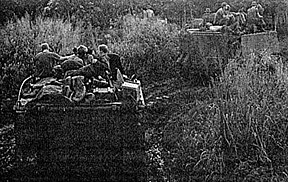
The Armored Personnel
Carrier
A Moving Fire Support Base
By SGT MIKE KEYSTER
OB LYNCH - It travels through mud, swamps, streams, and through seemingly
impenetrable jungle.
It saves miles of walking and enables 25th Division infantrymen to carry
extra gear and equipment. It carries handy little personal items that help a
"grunt" put up with all the miseries of the field. It even provides a warm and
dry place to sleep at night.
This handy, olive drab workhorse item to the Tomahawks of the 4th Battalion
(Mech), 23rd Infantry, is the armored personnel carrier (APC).
"My track can sleep up to six men," said Private First Class Phil
Gessert of Highland Park, Ill, an Alfa Company track driver.
"During the monsoon, it rains almost every night, but the guys can stay
dry in the APC."
Specialist 4 Ferman Bennet of Paxton, Ill., an Alfa Company track commander,
said his track enabled him to carry along his camera, tape recorder, radio and a goodie
box from home. "These things would be a lot harder to carry if I were in a straight
leg infantry unit," he said.
With the large storage and carrying capacity of the APC in mind Private First
Class Ted
Buckridge of Temple City, Cal., an Alfa Company rifleman said "on a
dismounted rif (reconnaissance in force), you only have to carry the equipment you need
for that day."
"The tracks are usually close by if we get into contact," Buckridge
added. Those 50s (50 caliber machine guns), are a real comfort."
Vines, trees, bamboo, and streams sometimes cause us to dismount and follow
the APCs," said Bennett, "but the tracks usually get through just about
anything. They are sure great for breaking trail."
"An APC is like a moving fire support base," said Gessert, in
summing up the advantages of an armored personnel carrier. "It brings you a lot of
comfort in the field."
Any 1l-Bravo would agree that the track sure beats walking.
Como is Lifeline To Outside
By 1LT, A.L. JOHNSON
OB LYNCH - At a fire support base, the lifeline to the outside world is
communications. If the line is cut, a lot more than conversation might be lost.
To make sure this doesn't happen at Operation Base Lynch, Company C, 125th
Signal Battalion maintains a VHF platoon working around the clock.
Consisting of 49 men, the platoon supports the 2nd Brigade with standard
communications as well as services ranging from switchboard operations to commo.
The men of the 125th at Lynch represent a wide variety of specialties in the
communications field. Each man is a vital link in the communications chain. Sergeant
Wayne Griffin, platoon sergeant, asserts that only through team effort can the platoon's
essential mission be accomplished.
"Here in the field, the men are more aware of the need for close
cooperation than ever before," he said. "Without a doubt, there is more of a
feeling of urgency for the importance of around-the-clock communications between Lynch and
other elements of the 25th Division."
"If we lost contact with the outside world, Lynch could become a mighty
lonely corner," said a newly arrived generator mechanic. "Each man here has an
important responsibility to keep up his end of the job."
The TROPIC LIGHTNING NEWS is an authorized publication of the 25th Infantry Division. It is published weekly for all division units in the Republic of Vietnam by the Information Office, 25th Infantry Division, APO San Francisco 96225. American Forces Press Service and Army News Feature materials are used. Views and opinions expressed are not necessarily those of the Department of the Army. Printed in Tokyo, Japan, by Pacific Stars and Stripes.
MG Edward Bautz, Jr . . . . . Commanding General
MAJ Robert E. Kelso . . . . Information Officer
1LT Martin E. Webb . . . . . Officer-in-Charge
SP4 William M. Lane . . . . . Editor
SP4 Scott Watson . . . . . . . Assistant Editor
SP4 Michael J. Winston . . Production Supervisor
BATTALION CORRESPONDENTS
| SGT Mike Keyster SP4 Tom Benn SP4 Frank Salerno PFC Dan Lowry SP4 Greg Duncan SP4 Rich Erickson SP4 Ed Toulouse SGT Mark Rockney SGT Mike Conroy SGT William Zarrett SGT Daniel House SP5 Tom Watson |
4/23 7/11 2/22 2/27 2/27 2/14 2/12 2/12 3/4 Cav 4/9 4/9 725th |
SP4 William McGown PFC James Stoup SGT Derr Steadman SP5 Doug Sainsbury SP4 James Duran SGT Jack Strickland SP4 Kris Peterson SP4 Frank Morris SGT Bob Lodi SGT Dan Davis SP4 Phillip Maslin PFC Doc Polis |
Divarty 65th Eng Discom 2/77 3/13 1/27 3/22 2/34 1/5 1/27 2/27 296th |
Page 3 TROPIC LIGHTNING NEWS October 26, 1970
Chasing Cu Chi
Critters
MPs are Going to the Dogs
By PFC DAVE COOPER
CU CHI - Should a 25th Division trooper wake up one morning and not find
Bowser chasing the hootch-maid around it may be because of the division's Dog Squad.
Because of a sudden dog population explosion, there is a current campaign
going on to control the number of stray animals running loose on this base camp.
The Dog Squad, consisting of four men from the 25th Military Police (MP)
Company, cruises the camp roads, keeping a sharp eye out for any strays.
"Just recently we received word that all pets must be on a leash and
tagged," said MP Private First Class Robert Neary.
"But instead of just hauling the dogs away to the Division Vet, we tell
the owners (if available at the time) that the dogs must be tagged and tied so that we
don't have to take them away "
"At first we only had to round up five strays per day, but now the quota
is up to ten," said MP Private First Class Jim Quigley of Tama, Iowa. "We
usually find them around mess halls at meal times."
The job is not one that boosts the MP's prestige.
"This job is a real hassle because it makes us look like the bad
guys," Neary of Phoenix, added, "and it doesn't give us a very good relationship
with other GIs."
"Its easy to pick up strays that don't belong to anyone, but lately
we've gotten a lot of harassment from guys when we take their dogs away," Quigley
said. "They seem to think this is our bag."
Once a dog is caught, it is taken to the 4th Medical Detachment, otherwise
known as the division vet. If the dog has been registered, the owner is notified. If not,
then the dogs are kept for 72 hours before they are ‘permanently’ processed.
An important off-shoot of the program is its health aspect.
"We've given rabies vaccinations to more than 700 canines since
May," Brewer added. "Thanks to the shots and the work of the Dog Squad we
haven't had any rabies cases since January."
Arty Survey Teams
Are Unsung Heroes
By SP4 JAMES DURAN
CU CHI - Each morning one sees them leaving base camp, their trucks and
jeeps loaded with an array of strange equipment. In the evening, they return to that
mysterious little shed, their rear area shop.
It's the survey section from the 3d Battalion, 13th Field Artillery (The
Clan) headed by Sergeant First Class Leroy Johnson of Neptune, N.J.
Artillery survey is an important segment of field artillery, yet little is
known about their job or responsibilities.
The mission of an artillery unit is to "shoot, move and
communicate." The mission of the artillery survey section is to provide the technical
firing and gun emplacement data, vital to the basic artillery mission.
On call day and night to preceed the guns to the new firing location, the
section must provide its security with a gun jeep and small arms. During the Cambodian
operation, men and equipment were loaded aboard choppers and inserted as an artillery
recon unit to plot azimuths for the guns soon to arrive.
"Upon reaching a location, we must determine the exact battery center
and the azimuth to the end of the orienting line through the use of our T-16
theodolite," said Johnson.
"This is an angle measuring instrument which we also use to take
astronomical readings. Using this we are able to plot the exact patch that the round will
take upon leaving the tube."
"If the weather is overcast we can accomplish our mission with the
azimuth gyro. The gyro will give us the information in any kind of weather. However, it
must used carefully being a sensitive instrument, costing $28,000.
"We also supply coordinates and altitude readings, but the important
factor is azimuth, the line over which the projectile will be traveling. Usually we supply
all three factors for the added safety of the people we support.
"And, if the guns have all the data, the number of rounds wasted is
decreased. Using all three factors, the Howitzers can have the first round on target, what
we call "The Sunday punch," said Johnson.
The Clan sun and star spotters are organized into two teams each headed by a
staff sergeant team chief. Next come the chief computers followed by the operators, the
tapemen and radio telephone operators.
As each man works together, they will rotate to a new job within the team.
Through cross training each man will be able to assume the duties of the next higher
grade. With this system, the section will seldom be out of operation with the loss of a
man.
IT’S HAPPENING
TROPIC LIGHTNING: A BELIEVER…Bulldog Smith
is new to the 25th Division but old to the war. The sergeant spent 14 months in the field
as an 11 Charlie with the 2nd of the 47th, a 9th Division outfit. He came through the
experience without a scratch. Nary a bullet, booby-trap, frag or mortar round could fell
the Bulldog. When the 9th Division closed up shop and went home recently, Smith was
transferred to the 25th to do his last few days. He was assigned to Admin Company and made
a duty soldier. One of Bulldog's duties was to pull a little bunker guard on a recent
stormy night. For some reason, Smith was standing in the bunker so that his head rested
against the metal roof - not the best place to rest it during tropic lightning time. A
bolt of the stuff took aim on Bulldog's bunker, zapped the roof and knocked him cold.
Happy ending. Bulldog came out of the thing with nothing more serious than a singed pate.
Unless lightning strikes twice in the same place, Smith is going home in 8 days. Sit
tight, Bulldog.
DON'T TRUST THE ARMY…When you DEROS, you may
have an assignment waiting for you in the States. Then again you may not. Personnel is
supposed to report you to the Department of the Army a full five months before you rotate.
But, experience has shown that they slip up enough to warrant a trip by you to the nearest
personnel palace to give them a little nudge.
LOVE IT OR LEAVE IT DEPT…Now, we all love
Vietnam. But, as it is often said, absence makes the heart grow fonder, and besides a
little leave never hurt anybody. Unfortunately, a lot of leave has been bugging USARV, or
should we say a lot of almost leave. It seems that some soldiers have been zipping down to
Tam Son Nhut every few days hoping to get on a flight, not making it and then spending a
few at Camp Alpha. That ain’t gonna get it any more. You have only one chance at
leave now. If you don't get on free, you have the option of paying for a seat or turning
tail and heading back for your unit. Thus, in addition to the $250 you needed before to
get out of country, you’ll need an additional sum to cover the cost of the ticket.
Here is a handy-dandy table of ticket prices to R & R sites:
Bangkok $72
Hong Kong 130
Taipei 218
Sydney 627
Hawaii 558
THE ROCK THAT WASN'T…One day
recently, Specialist 4 Bruce Stafford of Kingston, N Y, and Specialist 4 Neil Ringler of
Long Beach, California, were adding another wing to their bunker house when a large rock
imbedded in the bunker wall impeded their progress. They hammered at it and knocked it
about a bit but the thing wouldn't budge. "Let's dig it out," one of them said
during a brainstorm. Dig they did. And as they dug, the rock took on a familiar shape. It
wasn't a rock at all, heh, heh It was a live 155mm artillery round, heh, heh. The
explosive ordnance destruction team of the 2nd Battalion, 34th Armor was called in and as
our two heroes looked on, made it go boom
AND FROM SAN CLEMENTE…President Richard M.
Nixon signed a bill during the latter part of August increasing the interest rate on
Series E and H bonds to five and a half per cent. That means if you buy a $25 savings bond
at $18.75 today, in five years and 10 months you will be able to cash it in for $25.73.
The same five and a half per cent interest rate applies to bonds of higher denominations
as well. I guess that's the end of the good old $25 dollar bond. It's now a $25.73 bond.
Doesn't have the same ring.
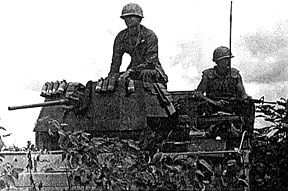 |
BREAKING THROUGH -- The men of this Bravo Company armored personnel carrier of the 2nd Battalion (Mech), 22nd Infantry, look for enemy positions as they move through thick brush 15 miles north of Cu Chi. (Photo by SP4 Frank Salerno) |
Page 4 - 5 TROPIC LIGHTNING NEWS October 26, 1970
Pages 4 and 5 contained a photo spread of ARVN units in the field with the 2/22nd. The photos were dark and contained no recognizable individuals, so they have not been reproduced here.
Triple Deuce, ARVN Combine to
Operate
Photos By SP4 Frank Salerno Story By SP4 Dennis LeBlanc
CU CHI - Elements of a 25th Division mechanized battalion team with 25th
ARVN Division soldiers in a large-scale operation near here recently, netting stores of
enemy supplies and two detainees.
Alfa, Bravo and Headquarters Companies of the 2nd Battalion, (Mech) 22nd
Infantry, worked with a Vietnamese battalion of the 46th Regiment. The three-day search
mission took place a mile east of Trung Lap village.
"Leaving at dawn, we linked up with the ARVNs at their previous night
ambush site and went to the area to be searched," said Specialist 4 Dave Rodriquez, a
Bravo Company machine gunner from San Antonio.
"When we reached the designated area to begin the rift, the tracks went
in first and the ARVNs followed, thoroughly searching the area."
It wasn't long before the ARVNs were uncovering freshly-dug tunnels and
fighting positions with heavy overhead cover. It was readily apparent that the enemy had
been there only hours before.
In an effort to avoid casualties from enemy mines and booby-traps that might
have been left behind, the combined force made extensive use of artillery and air-strikes
to prep certain areas.
"Judging from the number of secondary explosions set off by the arty and
air-strikes, we would have taken a lot of casualties had they not been used," said
Specialist 4 Paul Richmond, a Bravo Company medic from Peabody, Kan.
With the operation in its final day, the Allied force could list two
detainees, assorted ammunition, materiel for booby-traps and more than 250 pounds of rice.
The prisoners, one male and one female, were found hiding in one of the many
tunnels uncovered by the men of Alfa Company. After preliminary questioning, they were
evacuated by helicopter to an area where they could be more thoroughly interrogated.
Included in the ammunition supplies were AK-54 rounds, M-16 rounds smoke
grenade fuzes, springs, explosives and boxes of blasting caps. The rice was found wrapped
in sandbags and placed in a 55-gallon drum.
With the mission completed, Specialist. 4 Dennis Garrison, a Bravo Company
armored personnel carrier driver from Flint, Mich., came to a startling conclusion.
"Its been a long time since we were in terrain that thick and found
enemy positions that well fortified," he said. "It reminded us all of some of
our operations in Cambodia."
Page 6 TROPIC LIGHTNING NEWS October 26, 1970
Ask SGT Certain
DEAR CERTAIN: I fell asleep while on bunker
guard last week. I wouldn't have been caught except that a Hoi Chanh tried to turn himself
in and when he couldn't awaken me, he took my weapons to the orderly room where he gave
them to the first shirt. I was given an Article 15, busted to E-2 and fined $75 for the
next three months. I appealed on the grounds that I didn't know how to use the M-60 or the
M-79 which I was given to guard the bunker. If I had been studying the weapons manual,
they claim, I wouldn't have fallen asleep. The first sergeant said phooey. Should I appeal
to a higher level?
Former PFC Fairweather
DEAR FAIREY: You could, but you'd be better off
studying for the E-2 board which meets next month.
DEAR SERGEANT CERTAIN: I had been trying to get
into the PX ever since payday. Finally, last week, after spending three days and four
nights in line, I was able to get in. It took me another 14 hours to gather up all the
supplies I needed. Then, of course, I had to wait in the checkout line. I don't know how
many days I waited, but when I got up to the counter, the girl-san told me that C-day had
been declared and that none of my MPC was valid. When I tried to leave the PX to get my
old MPC exchanged, the courtesy guard wouldn't let me out because my ration card hadn't
been stamped indicating I had exchanged my MPC. When I tried to explain this to the guard,
he told me he had to follow orders and I could not leave the PX without a stamped ration
card. I am writing this letter from the PX manager's office. It is now 1 a.m. and I am the
only one here-except for the ever-present courtesy guard. Can you help me?
Private Entrance
DEAR ENT: If you had been alert, you could have
secured plenty of the new MPC three days earlier from any mama-san at Cu Chi.
Small Fry Harvest
King-Sized Gis Charm Kids
By SP4 FRANK MORRIS
DINH AN - Members of the 25th Division's 2nd Battalion 34th Armor, helped
to make "Moon Harvest Day" in Vietnam a little brighter for local children here
.
The children, who live on the outskirts of a nearby rubber plantation, were
visited by a gang of Dreadnaughts who played games with them, brought food, and observed
their singing program.
The GIs got things rolling with jump rope, tug-of-war and football games. The
kids took up the American games quickly and, from then on, it was Katie bar the door.
Some of the children watched with wonder as the seemingly king-sized GIs
boomed the football high into the air while others attempted to catch it.
In the midst of the festivities a light observation helicopter buzzed
overhead and zoomed down to land on the edge of the village. In it was battalion
commander, Lieutenant Colonel Birtrun S. Kidwell, Jr., who had come to join the
festivities.
After the children sang some songs for him, the Dreadnaught leader skied up
and away.
Forming neat rows in the schoolyard, the kids then welcomed the district
chief Lieutenant Colonel Ta-Trung-Quan, their guest of honor.
Singing Vietnamese national songs for the chief, the children were loudly
applauded. After the show there were fruit, grab-bags and kool-aid for the happy
youngsters.
As the Americans got ready to leave, the children gathered around them.
Although there was little verbal communication between the GIs and the Vietnamese this
day, another kind of communication took place which will last much longer.
An Olympic Hopeful Runs Cu
Chi Roads
By SP4 J. D. DRURY
CU CHI - "Running is a release, a momentary escape from the day's
activities and small frustrations."
With these words captain William A. Matheson of the 25th Division excused
himself and headed for his hootch to don track shoes and red shorts.
Twice daily between 5:30 and 6:00 p.m., and between sets of calisthenics, the
executive officer for Headquarters and Company A, 25th Medical Battalion, hits the
blacktop for a sprint around his improvised track: Oahu Road to Lanai Road to Hawaii Road
to Taro Road and back up Oahu Road to the medical battalion area.
But there is an ulterior motive to this daily ritual, for Matheson is a
member of the Army Pentathlon Team and a US Army nominee to the Olympic trials.
"My interest in track started in high school where I was motivated by a
coach," said the Eagle Rock, Calif., athlete. While in high school he placed second
in the City Championships in nearby Los Angeles which earned him a track scholarship to
California State College where he still holds the school record for the 440.
After coming into the Army in 1964, Matheson was sent to Stuttgart, Germany,
where he was made director of the American Youth Association, Kelly Barracks, Seventh
Corps Headquarters. Four months after his arrival he applied for, and was accepted by, the
Army Pentathlon Team, training at Bad Toltz in the Bavarian Alps.
In competition between teams from Switzerland, Austria and the US he placed
second in pentathlon events: weaponry, throwing hand grenades, running a 500 meter
obstacle course, swimming a 50 meter obstacle course and running five miles.
After his tour in Vietnam, which he finds a "needed break after four
years of steady training," Matheson plans to "make a try for the '72
Olympics."
But until then he will keep on working out, adding to his 108,000 leg raises,
18,000 push-ups, 6,000 chin-ups, and 1,600 miles of running.
Page 7 TROPIC LIGHTNING NEWS October 26, 1970
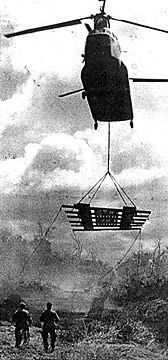 Engineers Bridge The Gap
Engineers Bridge The Gap
By SP4 RICH WERNER
DAU TIENG - The steaming jungle primeval and thick with bamboo, is not the
most ideal place for building a bridge. But recently, the 65th Engineer Battalion's Alfa
Company was assigned such a task.
Needed Means
The 3rd Squadron, 4th Cavalry, operating in the area northeast of Nui Ba
Den, needed a means to get their heavy tracks across a small stream.
Normally, an armored vehicle launching bridge (AVLB) would have been used,
but the only road leading to the site was festered with land mines and the enormous weight
of the AVLB precludes transport by air.
Decision
After reconning the area, it was decided that a 38-foot dry span bridge
was needed. The frame, built here, and five tons of balk (flooring for the bridge) were
flown via Chinook to the site where the engineers were waiting.
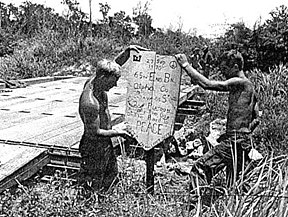 Working in the stifling heat, the 2nd Platoon Savages lugged the balk, each piece weighing
225 pounds, into position on the bridge frame.
Working in the stifling heat, the 2nd Platoon Savages lugged the balk, each piece weighing
225 pounds, into position on the bridge frame.
Speed, Teamwork
Speed and teamwork are essential to the combat engineers. This task
pointed up the necessity of these tenets. Without a break, they completed the bridge in
only two hours.
As the first Sheridan tank rumbled across the span, the tired Savages tacked
up a sign bearing their motto: "Bridging the Gap on the Road to Peace."
DUST IN - (Above, left) A Chinook in support
of the 25th Infantry Division lowers a bridge frame over a stream, as members of the 2nd
Platoon Alfa Company, 65th Engineers look on.
FINISHING TOUCHES - (Above, right) Members
of Alfa Company, 65th Engineers, display their cornerstone sign after completing a 38-foot
dry span bridge northeast of Nui Ba Den.
|
BRIDGING THE GAP - Members of Alfa Company, 65th Engineers construct a 38-foot dry span bridge, eight miles northeast of Nui Ba Den. The frame and the five tons of balk flooring are flown in by Chinook, and then assembled. |
Page 8 TROPIC LIGHTNING NEWS October 26, 1970
Aidman Is Comedian Is
Bard
This Groucho Leaves Marks
By SP4 FRANK MORRIS
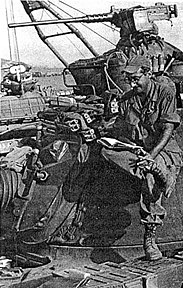 DAU TIENG - Take one part comedian, add some poetry, season with medical training and let
simmer with a deep sense of brotherhood and you have quite a unique individual known to
his
DAU TIENG - Take one part comedian, add some poetry, season with medical training and let
simmer with a deep sense of brotherhood and you have quite a unique individual known to
his
25th Division buddies as "Groucho."
He is Specialist 4 William H. Clamurro of Nutley, N J., a senior aidman of
Bravo Company, 2nd Battalion, 34th Armor.
Nicknamed Groucho because of his resemblance to the famous comedian, Groucho
Marx, and because of his ever-present cigar he has brought a sense of levity to the
serious job of conducting a war.
Grimey tankers form lines to tell Clamurro of their ailments, such is the
renown of his medical knowledge. But after one particularly long and elaborate list of
symptoms from a loquacious patient he finally told the man to "take two aspirins and
call me in the morning."
There is a serious side to the man, however. He has obtained a master's
degree in English literature from the University of Washington and taught at the graduate
level there. He also regularly corresponds with American poet, Archibald MacLeash, who was
his mentor for his four years at Amherst College.
He has had poetry published in the Upstart of Princeton University, the
literary magazines of Amherst College and the University of Massachusetts.
A conscientious objector, Groucho is armed only with a medical aidbag and an
ever-present book. He is looked upon by Bravo members as a very competent medic whose main
prescription for their woes is a heavy dose of humor tempered with a spot of medicine .
Modern Dog Houses Have Running Water
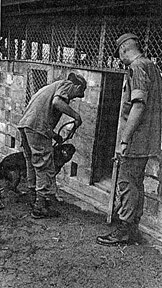 CU CHI - The 25th Division's 44th Infantry Scout Dog Platoon recently held a leash cutting
ceremony here marking the opening of the new Hartsock Kennels.
CU CHI - The 25th Division's 44th Infantry Scout Dog Platoon recently held a leash cutting
ceremony here marking the opening of the new Hartsock Kennels.
"These new kennels will help keep the dogs healthy," said 1st
Lieutenant Russell Murphy, platoon leader. "Last month half of the dogs were on
medical hold." There are 23 dogs in the platoon.
Different
"The new kennels are quite different from the old shipping crates
in which the dogs had been quartered," Murphy said. "It took just 29 days to
construct them." The Kennels consist of 28 brick cubicles with electric lights
and running water in each.
Highlighting the ceremony was the cutting of the leash by Division Chief of
Staff Colonel Thomas Hanifen.
In Memory
The kennels are named in honor of Staff Sergeant Robert Hartsock who
received the Congressional Medal of Honor posthumously while serving with the 44th Scout
Dog Platoon.
Hartsock was killed after throwing himself on a satchel charge during an
attack on a 25th Division base camp at Dau Tieng on February 23, 1969.
After suffering initial wounds, Hartsock crawled about five meters to a ditch
and provided heavy suppressive fire, allowing his platoon commander to crawl to safety.
Hartsock kept the enemy infiltrators pinned down until he died.
NEW HOME - (Above, right) Duke, a German
Shepherd with the 44th Infantry Scout Dog Platoon, is let into the new Hartsock Kennels
following the leash-cutting ceremony.
Dustoff Unit
Serves Division
Flying Ambulances Respond
By SP4 J. D. DRURY
CU CHI - The 25th Division known for its rapid reaction, has no offspring
more responsive to an urgent call than its foster child, the 159th Medical Detachment
Dustoff.
This helicopter ambulance unit, part of Long Binh's 58th Medical Battalion,
provides medical evacuation for much of the Tropic Lightning Division's area of
operations.
The Call
"Cu Chi Dustoff, Cu Chi Dustoff, this is..." begins the
continuous ritual in the Dustoff Control Room in the 25th Medical Battalion's operations
center.
"Problem, location coordinates, call sign, security of the landing zone,
and other bits of information are quickly and accurately gathered; then the first up AC
(aircraft commander) is immediately called" stated Dustoff radioman Private First
Class Stanley Siembrzuch of Chicago.
Airborne
"Within five minutes after we are first called we can be
airborne," said Warrant Officer Cecil Howard, an Independence, Mo., AC nearing his
thousandth Dustoff night hour.
"Each crew -- AC, pilot, medic, and crew chief -- is on for a 24-hour
period, with the first up crew having a five minute reaction time" explained Dustoff
Flight Operations Officer, Captain Bruce Nelson of San Antonio, Texas.
"The second up crew," he continued, "flies transfers from Dau
Tieng to Cu Chi, or to hospitals in Long Binh or Saigon, while third up is a standby
status."
Specialist 4 lames Coverick, a Dustoff crew chief from Chicago added that
"the crew in Dau Tieng picks up anyone in that area and takes them to the 25th Med
Aid Station there."
Cambodia
"During the Cambodia Campaign we operated two ships instead of just
one at Tay Ninh," said Detachment commander Captain Vincent Eitler, Jr., of Steelton,
Pa. "But now since the Division’s 1st Brigade has moved its headquarters to Dau
Tieng, we have our standby ship and crew there."
"We were the first medical evacuation team to fly into Cambodia,"
responded Captain Donald Kaveny, one of Dustoff’s twelve evacuation pilots.
"During the campaign we gave Dustoff coverage to the Angel's Wing, the
Fishhook, and points between," added the Pawlet, Vt., officer.
Busy
The entrance into Cambodia was indeed a busy time for 159th Dustoff.
"The number of patients evacuated jumped from 1,530 in April (about
average) to 2,632 in May and 2,121 in June," stated Warrant Officer Thomas Landis of
Wheaton, Md., another Dustoff evac pilot with 1,000 flight hours. Flight hours rose too,
from April's 478 to 761 and 610 for May and June, respectively.
War Stories
And the Dustoff crew has their share of "war stories" too.
"Night missions can be hairy, and so can hot LZs," commented Specialist 4
Larry Armstrong, Hampton, Va.
However, among war stories, Specialist 4 Mike Wilson's should earn at least
an honorable mention. The Philadelphia, Miss., medic delivered a baby-san in flight. After
picking up the pregnant mother in Cu Chi, the chopper proceeded on to a Saigon hospital,
but midway, midwife Wilson added another passenger to the manifest.
Why go Dustoff?
"Too many John Wayne movies," joshed Specialist 4 Michael
Warner from Albany, N.Y.
"Its interesting and its worthwhile," said an Oak Creek, Wisc.
medic, Specialist 4 Robert Cech who agreed with Warner that, "In Dustoff, you often
feel like you're doing that little bit more. "
Satisfaction
Self-satisfaction is high on the list of factors motivating what Eitler
calls "a topnotch dedicated crew."
The spirit of the unit was succinctly captured in a remark by one of the
medics, Specialist 4 Edward (Chili) Ianuccilli of Hope, R.I.
"When there's nothing that you won't do to save a life, that's when
you're doing your job "
Thanks to
Ron Leonard, 25th Aviation Bn., for locating and mailing this issue,
Kirk Ramsey, 2nd Bn., 14th Inf. for creating this page.
This page last modified 8-12-2004
©2004 25th Infantry Division Association. All rights reserved.